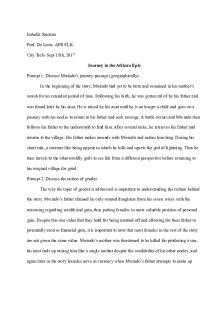UNIT III Essay - How have African American artists in the twentieth century incorporated stylistic PDF

| Title | UNIT III Essay - How have African American artists in the twentieth century incorporated stylistic |
|---|---|
| Author | Ashante Smith |
| Course | African - American Humanities |
| Institution | Valencia College |
| Pages | 4 |
| File Size | 63.8 KB |
| File Type | |
| Total Downloads | 15 |
| Total Views | 148 |
Summary
How have African American artists in the twentieth century incorporated stylistic elements and/or cultural influences from Africa art in their works?
How did African American artists respond to changes in social and cultural awareness throughout the twentieth century?...
Description
Smith 1
Ashanté Smith Professor Wright HUM-2454-3461 11 July 2020 The New Negro Movement “Music and poetry, and to an extent the dance, have been the predominant arts of the American Negro”(Alain Locke) During the New Negro Movement in the of the early twentieth century, African American artists changed the perception of themselves demonstrating that they were capable of high artistic and intellectual expressions. The New Negro Movement was a move to humanize the image of African Americans. It was an attempt to reinvent black people in ways that transcended the plantation images that were frequently seen at the time. According Michael D. Harris, “During the New Negro Movement of the early decades of this century, African-American artists began to investigate their African heritage. The stylized form of this carving deliberately recalls the contained frontal figures frequently seen in African sculpture.” In 1925, Alain Locke called for African American artists to look to traditional African Art for inspiration. This laid the foundation for significant subjectification of black people. Many African American artists responded to this call by looking into ideas about Africa and Africans in their work. By the late 1960s, the Black Arts Movement had completed the integration of political thought and cultural action into African American art expression heightening the identification of African Americans with their African history and culture. When African art is used as a resource by African American artists, it provides an icons and meanings. A vision and interpretation of their existence.
Smith 2
African American art during the early twentieth century was also used a response to changes in social and cultural awareness. “With much fanfare and to a hall filled to capacity, a group of African American ministers declared Jesus to be black (Negro World 6 Sep. 1924: 4). This event indicated the growing need to clarify the color of God in the African American religious community. The heightened racial awareness spawned by the Harlem Renaissance brought the color of everyone, including Christ, to the fore.”(Kymberly N. Pinder, 233) Black Christians struggled to fully accept God. Some black people rejected Christianity entirely because of its connection with white oppression. For some others, to reject that is something so deeply rooted in their culture was too hard to bear. They either ignored the hypocrisy or tried remedy it. Many African American artists addressed this struggle in their art by depicting racialized biblical subjects. According to Pinder, “The motif of the suffering Christ in their paintings engages issues of African American cultural identity which were relevant then and still are today. From depictions of the crucifix in black genre scenes to the conflation of the crucified Christ and the lynched black man, these images present Christ as a symbolic device charged with racial/religious meaning.” Christianity in African American art is presented as a both a source of relief and conflict. The work shows the “undeniable racial dimension” of religion demonstrated in black America. For African American artists and Christians, many believed that their race hindered the development of the dominant cultural models. For them, to fully embrace their faith or profession meant that they were rejecting and element of their racial identity. This theme of suffering Christ reflects their efforts to recognize and reinforce a piece of their identity into the African American experience. (Pinder, 232) In short, the Harlem Renaissance brought about a newfound appreciation for not only one’s culture but also their religion. In a society where racism was so prevalent, the creation of
Smith 3
music, art, and poetry was a way to demonstrate racial pride. This movement paved the way for social equality not only the arts but also within the American society.
Smith 4
Works Cited Harris, Michael D. “From Double Consciousness to Double Vision: The Africentric Artist.” African Arts, vol. 27, no. 2, 1994, pp. 44–95. JSTOR, www.jstor.org/stable/3337093. Accessed 11 July 2020. Pinder, Kymberly N. “‘Our Father, God; Our Brother, Christ; or Are We Bastard Kin?": Images of Christ in African American Painting.” African American Review, vol. 31, no. 2, 1997, pp. 223–233. JSTOR, www.jstor.org/stable/3042461. Accessed 11 July 2020....
Similar Free PDFs
Popular Institutions
- Tinajero National High School - Annex
- Politeknik Caltex Riau
- Yokohama City University
- SGT University
- University of Al-Qadisiyah
- Divine Word College of Vigan
- Techniek College Rotterdam
- Universidade de Santiago
- Universiti Teknologi MARA Cawangan Johor Kampus Pasir Gudang
- Poltekkes Kemenkes Yogyakarta
- Baguio City National High School
- Colegio san marcos
- preparatoria uno
- Centro de Bachillerato Tecnológico Industrial y de Servicios No. 107
- Dalian Maritime University
- Quang Trung Secondary School
- Colegio Tecnológico en Informática
- Corporación Regional de Educación Superior
- Grupo CEDVA
- Dar Al Uloom University
- Centro de Estudios Preuniversitarios de la Universidad Nacional de Ingeniería
- 上智大学
- Aakash International School, Nuna Majara
- San Felipe Neri Catholic School
- Kang Chiao International School - New Taipei City
- Misamis Occidental National High School
- Institución Educativa Escuela Normal Juan Ladrilleros
- Kolehiyo ng Pantukan
- Batanes State College
- Instituto Continental
- Sekolah Menengah Kejuruan Kesehatan Kaltara (Tarakan)
- Colegio de La Inmaculada Concepcion - Cebu















